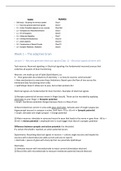Summary
Summary of The Adaptive Brain: all course lectures
- Course
- Institution
- Book
This summary contains everything that was mentioned during the lectures of Adaptive Brain and it contains importants pieces from the study book, Neuroscience (Purves).
[Show more]




